Taiyo A30449R R/C MINI JET HOVERCRAFT - RECEIVER User Manual USERS MANUAL
Taiyo Co., Ltd. R/C MINI JET HOVERCRAFT - RECEIVER USERS MANUAL
Taiyo >
USERS MANUAL
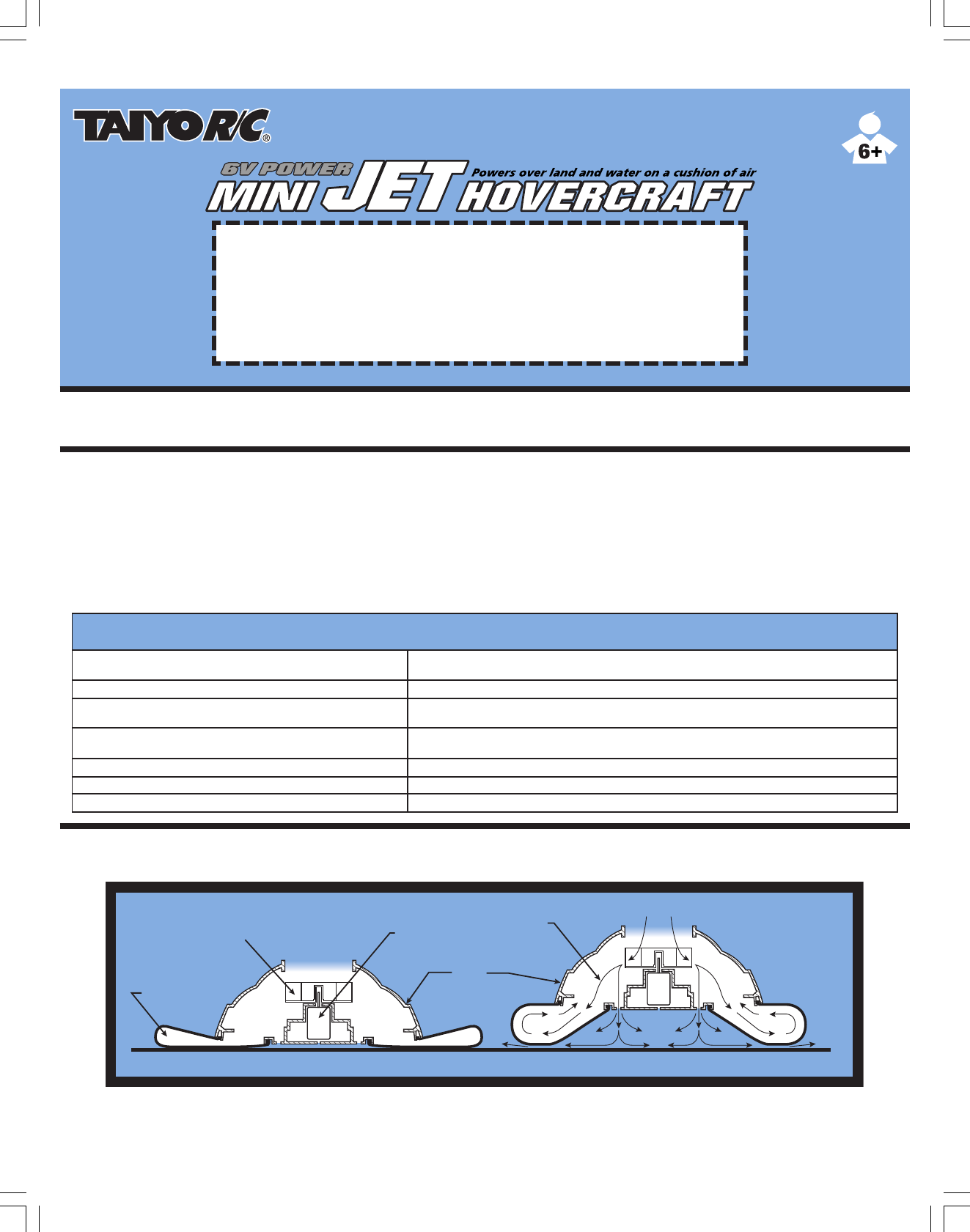
•No wheels
•Goes on floor, dirt, pavement, ice, snow
•Multi-terrain capable
•Goes on fresh water (pool, pond or lake, not salt/sea/
ocean water)
•True amphibious hovercraft
•High-power, double motor design
•Real rubber air bag skirt
•Rides on cushion of air created by lift fan blowing downward and into air bag
“skirt”.
•Needs flat, smooth, clean surface so skirt can “seal” with ground for best results.
•Not for use on rough or broken pavement/ground, carpet, rocks, pebbles, grass,
decking, hills, inclines or any surface that “lets the air out” or damages skirt.
•Pilot must keep craft within radio and battery life range on water to ensure retrieval.
•Not a boat; needs lift fan on with full power and air bag skirt inflated to float properly.
•Battery life 10-15 minutes between charges, depending on battery.
•Skirt is durable but can puncture on sharp rocks, sticks.
OWNER’S MANUAL
Important! Please read your Owner’s Manual all the way through before operating your hovercraft. Contains important information—keep for future
reference.
Safety First
•Adult supervision is recommended.
•Adult supervision strongly recommended, and use extra caution, when playing near water or ice. Do not go onto ice on a lake or other body of
water that might be dangerous if it breaks.
•Drive your hovercraft in a safe area away from people, pets, cars, etc. Not in streets, not in darkness!
•Don’t touch or try to pick up hovercraft when it is in motion. Wait until it stops completely.
•Keep hair, fingers, face and loose clothing away from top and rear propellers while the hovercraft is switched on or while the transmitter is
operating.
•Never block rotation of top lift fan or stick any object through top, bottom or rear grilles.
•Do not drive hovercraft into walls or other hard objects.
•Be a responsible Mini Jet Hovercraft™ operator!
NOTICE: EXOTIC HOVERCRAFT! NOTE SPECIAL OPERATING CONDITIONS
How it Works
Lift fan/air compressor blows downward, inflating air bag skirt, which seals with the ground and creates a cushion of air under the hovercraft.
Propellers at rear of hovercraft provide thrust for movement along the ground.
Surface
Air Bag Skirt
Motor
Body
Air Flow
Fan
Batteries and Charger
(included)
TAIYO exclusive 6.0-Volt Rechargeable NiMH Battery Pack and Battery Charger for NiMH Battery Packs
(This 6.0V NiMH Battery Pack is specially developed for this MINI JET HOVERCRAFT)
One 9-Volt (6F22) Battery for Transmitter (not rechargeable)
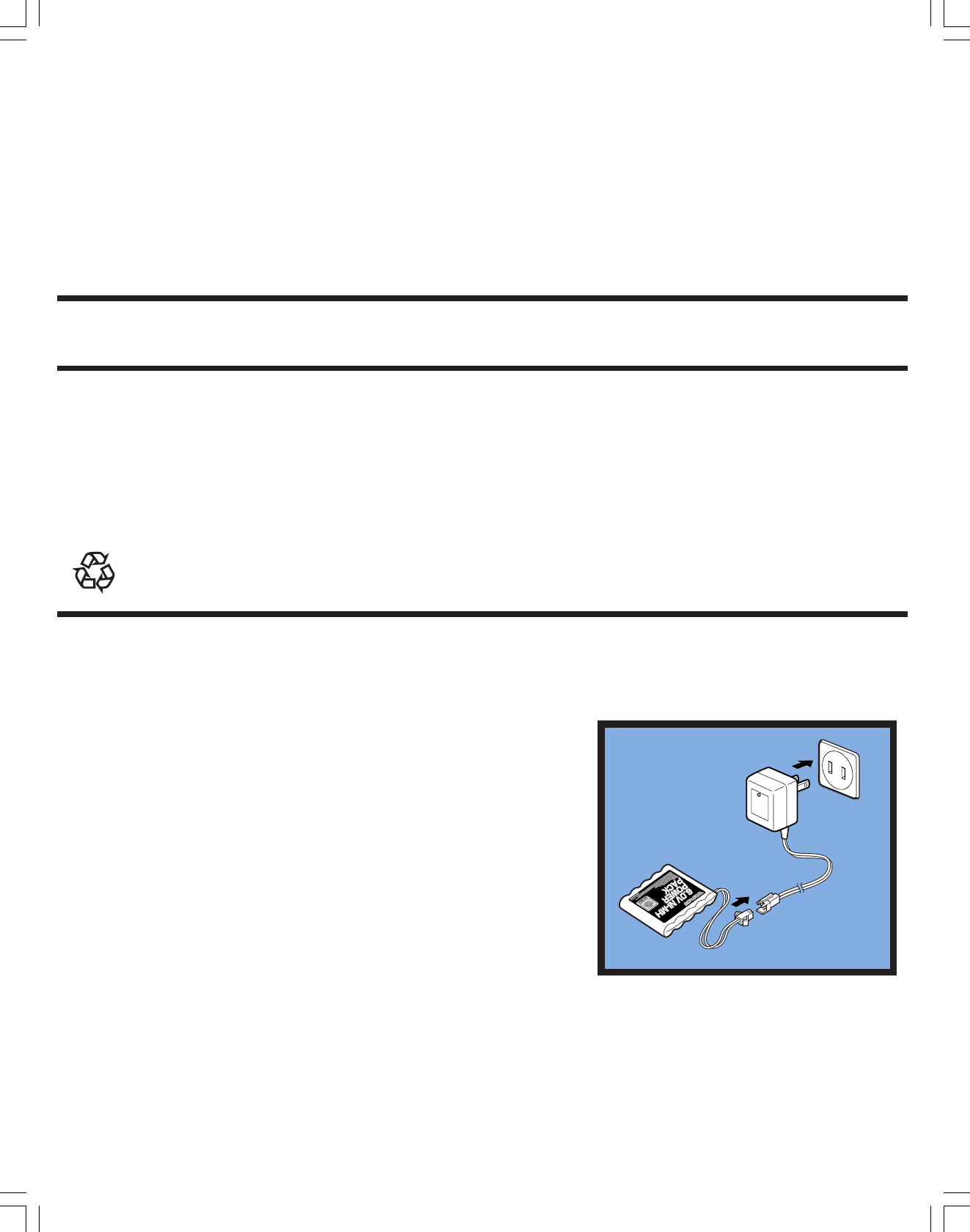
Battery Cautions
CAUTION: TO AVOID BATTERY LEAKAGE
1.Make sure the batteries are inserted correctly and follow the toy and battery manufacturer’s instructions.
2.Make sure battery polarity (direction) is correct.
3.Use only battery type(s) recommended.
4.Remove rechargeable batteries from the product before charging. Recharge batteries only under adult supervision and follow the battery and
charger manufacturers’ instructions.
Other Battery Cautions
1.Use caution removing battery from hovercraft after use. Battery may be hot.
2.Never pull the battery pack out of the hovercraft by the wire or plug. Never unplug the battery plug by pulling on the battery.
3.Remove batteries from the product for storage.
4.Do not recharge non-rechargeable batteries.
5.Do not short-circuit battery terminals.
6.Dispose of batteries safely and properly, according to your local requirements.
NOTE: NICKEL METAL HYDRIDE BATTERIES MUST BE RECYCLED OR DISPOSED PROPERLY.
Battery Charging and Care
(Batteries and Charger included)
Hovercraft will not run without a TAIYO exclusive 6.0V rechargeable NiMH battery pack and matching charger, adult supervision of battery charging is
recommended.
ADDITIONAL IMPORTANT BATTERY SAFETY INFORMATION
•Regularly examine charger and battery pack for damage, including plugs, casings and all other parts. If damaged, do not use.
•Not a toy—not intended for children under 3 years old.
•Make sure the batteries are inserted with the correct polarity and follow the toy and battery manufacturers’ instructions.
•Remove weak or exhausted batteries from the product.
•An adult should help with battery replacement
•Only batteries of the same or equivalent type as recommended in the “Battery Installation” (or replacement) instructions are to be used.
•Non-rechargeable batteries are not to be recharged.
•If removable rechargeable batteries are used, they are only to be charged under adult supervision.
•Rechargeable batteries are to be removed from the product before they are charged.
•If you use a battery charger, it should be examined regularly for damage to the cord, plug, enclosure and other parts. Do not use a damaged battery
charger until it has been properly repaired.
•Dispose of batteries safely and properly.
THIS PRODUCT USES A NICKEL METAL HYDRIDE BATTERY. MUST BE RECYCLED OR DISPOSED PROPERLY.
Contact your local area office of solid waste management or other appropriate local agency for information.
Running and Charging Times
1.NiMH battery packs are not like alkaline batteries. They lose all their power suddenly, not gradually, and hovercraft will stop very soon after slowing
down becomes noticeable, with little warning. This is normal, but keep it in mind, especially when operating on water, since you need to get the
hovercraft back before the battery power runs out.
2.Typical running time will be between 10 - 15 minutes for a typical freshly charged NiMH battery pack in good condition, but do not rely on this until
you observe how long your battery runs in your hovercraft under the conditions you operate in. Running time may vary over life of battery, with the
first few charge cycles yielding shorter run times than later charges.
NiMH
BATTERY CHARGING INSTRUCTIONS
NOTE: “CONDITION” BATTERY PACK FOR BEST RESULTS BY CHARGING ACCORDING TO THESE
INSTRUCTIONS ON EVERY CHARGE. ON THE FIRST CHARGE, EXPECT A SHORTER RUN TIME.
RUN TIMES WILL INCREASE OVER THE NEXT 6 CHARGES, REACHING SPECIFIED RUN TIMES.
Drain Down — Cool Down — Charge Up
1.After the first charge, for best performance always run the battery pack all the way down
before recharging. Run until vehicle wheels/fans/motors slow to a stop.
Note: If you are operating a boat, hovercraft or other water vehicle in water, retrieve the
vehicle while battery power is still strong and perform this Drain Down procedure on land.
(Don’t operate other kinds of vehicles in or near water.)
2.Allow the battery pack to cool before recharging.
Battery Heat
1.Battery gets hot after use! This is normal, but be careful. Wait until battery is cool (20
minutes or more if needed) before charging. Charging batteries when they are hot will
severely reduce the number of times they can be recharged.
2.After charging, battery pack will be warm. This is normal.
RECHARGING INSTRUCTIONS
1.Plug wall pack charger into a standard wall outlet.
2.Connect the battery pack plug to the charger plug as shown.
3.Red light on charger will light to show charger is operating. Normal charging time is approximately 4 hours.
4.Unplug charger from wall after 4 hours of charging.
5.After charging, battery pack will feel warm. This is normal.
Rechargeable Battery Tips
1.Don’t overcharge the battery pack. Unplug the charger from the wall at the end of the recommended charging time.
2.NiMH battery packs are not like alkaline batteries. They lose all their power suddenly, not gradually, and vehicle will stop very soon after slowing
down becomes noticeable, with little warning. This is normal, but keep it in mind, especially when operating on water, since you need to get the
vehicle back before the battery power runs out.
3.Store your battery pack discharged.
4.Your battery pack will hold a charge for a shorter time in hot weather. Otherwise, you can charge a battery a day or so in advance of when you want
to use it or give it as a gift.
5.It’s better to charge for the full 4 hours, even though the vehicle may operate with a partial battery charge.
6.When your battery pack’s running time gets shorter and shorter, probably it’s getting close to the end of its life and needs to be replaced.
This product
should be used
with adult
supervision
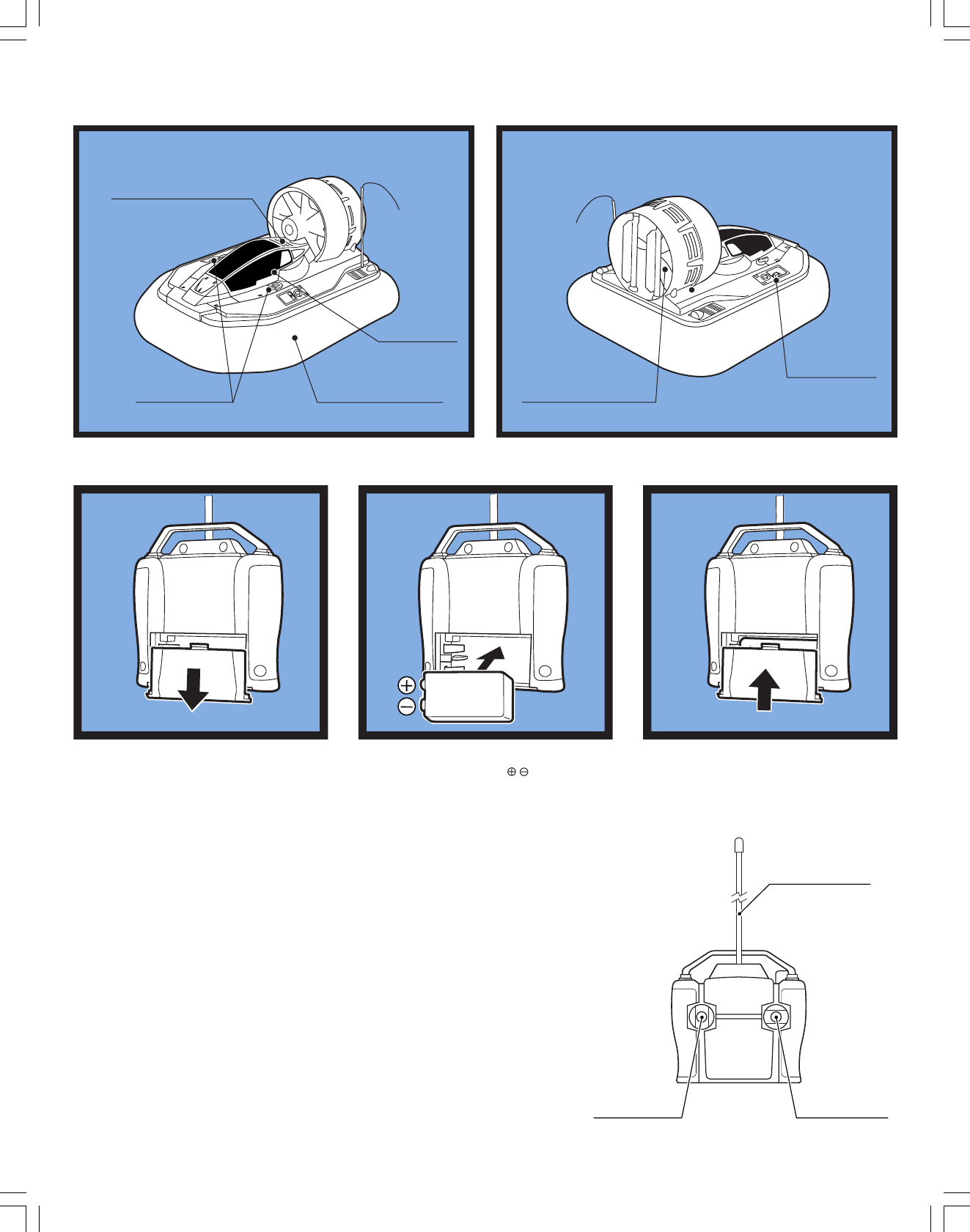
Transmitter Battery Installation
1.Slide open BATTERY DOOR on back of
Transmitter. 2.Insert a fresh, new 9-VOLT (6F22) BATTERY
with the correct polarity( /) as shown on
the inside of battery compartment.
3.Hold battery in place with thumb and
replace BATTERY DOOR. (Do the opposite
process indicated in 1.)
Fig 1 Fig 2 Fig 3
●Transmitter
The Transmitter does not have ON/OFF switch. The switch will be ON only when the stick is
in control. The switch will be OFF after a period of non-use.
Transmitter Antenna
LEFT/RIGHT TURN
Control Stick
FORWARD/BRAKE
Control Stick
Hovercraft Features
●Hovercraft
Rubber Air-Bag Skirt
Lift Fan(Air Compressor)
Battery Latches
Battery Door
Single Drive Propeller
Power Switch

Hovercraft Battery Installation
4.Replace BATTERY DOOR by aligning the door
and compartment, lowering rear of door into
place and turning LATCHES to locked position
(Do the opposite process indicated in 1.)
5.Check operation by turning power switch to
ON and then OFF again. Power switch is
located on the top right of hovercraft. Lift Fan
should go ON and OFF. If not, remove and
reinsert the battery plug. Turn the power
switch OFF to save power while changing
battery whenever possible.
1.Confirm that the main switch is OFF. Turn
LATCHES on vehicle BATTERY DOOR, lift door
at rear and remove.
2.Insert fully charged BATTERY PACK into
battery compartment as shown. Observe
position of wire as shown.
3.Firmly insert BATTERY PLUG all the way into
SOCKET as shown. Make sure the “key”
(bump) on plug is facing downward to fit into
notch in socket.
Only use exclusive 6.0V rechargeable Ni-MH
battery Pack (included) for proper function &
safety.
*Check whether the rechargeable batteries are
fully charged before insertion.
*For charging process, please read the
BATTERY CHARGING INSTRUCTIONS.
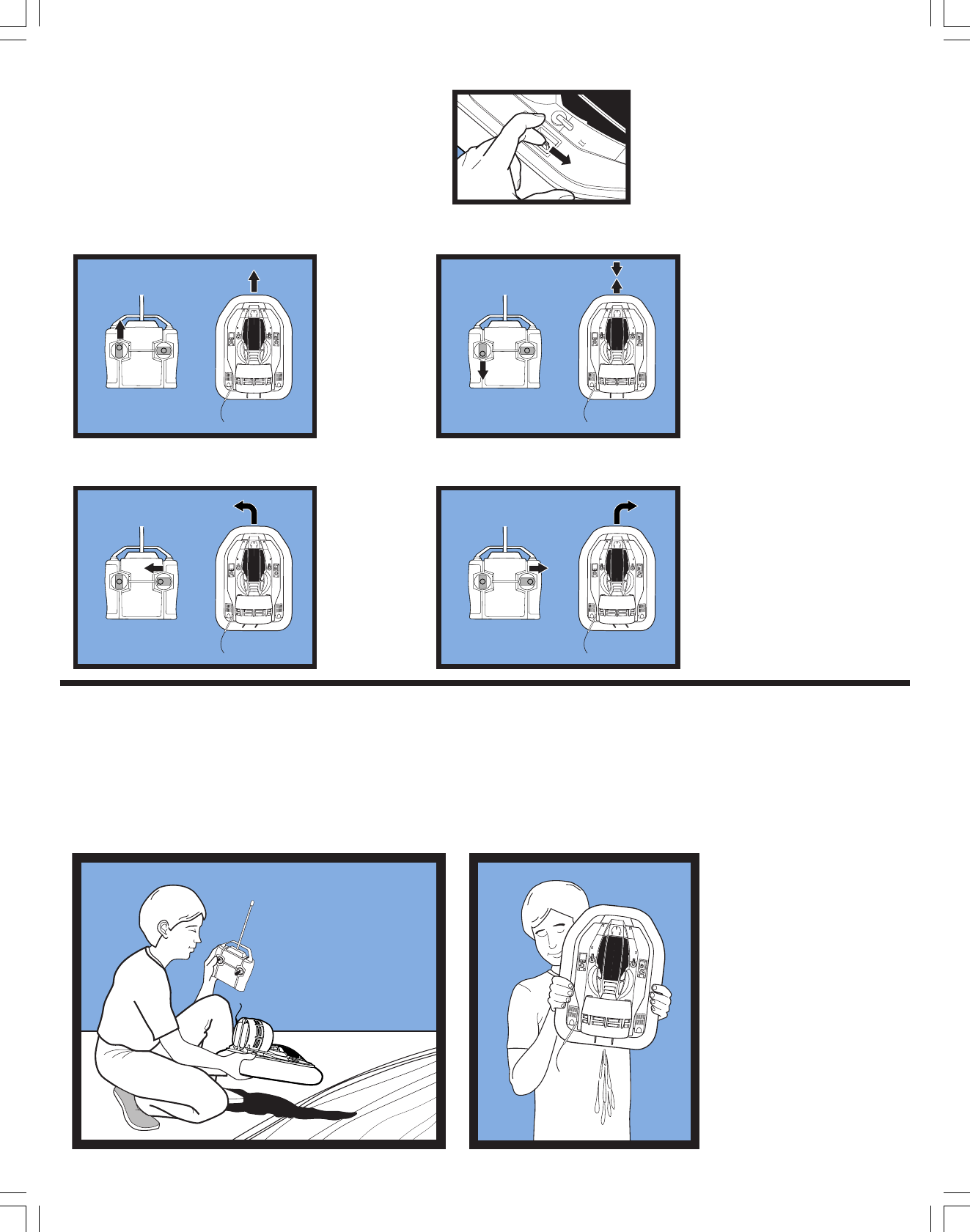
Operating on Water
Fresh water only--not sea or salt water!
CAUTION: ADULT SUPERVISION IS STRONGLY RECOMMENDED WHEN OPERATING ON OR NEAR WATER OR ICE.
Important: Time the use of the hovercraft on water so you can recover it before the battery runs out! Run for only 5
minutes each launch with a freshly charged battery to be sure.
Launching
1.Turn hovercraft power on.
2.Hold hovercraft as shown. Make sure lift fan is at full speed and air bag skirt is fully inflated. Carefully place hovercraft on water. (Fig. 10)
Important: Lift fan must be operating for hovercraft to operate properly. Air bag skirt may fill with water if lift fan is not running.
3.When removing from water, remove battery door and battery pack, hold hovercraft as shown and shake out excess water. (Fig. 11) Dry hovercraft
after use with a clean soft cloth.
How to operate your Hovercraft
●Before operating the hovercraft, turn the switch ON.
(The lift fan will operate and hovercraft will be in lifted position)
●FORWARD
Push the LEFT stick up. Release to coast.
●BRAKING/REVERSE THRUST
Push the LEFT stick down.
●LEFT TURN
Push the LEFT stick up and turn the RIGHT stick to the left.
●RIGHT TURN
Push the LEFT stick up and turn the RIGHT stick to the right.
Fig. 10
Fig. 11
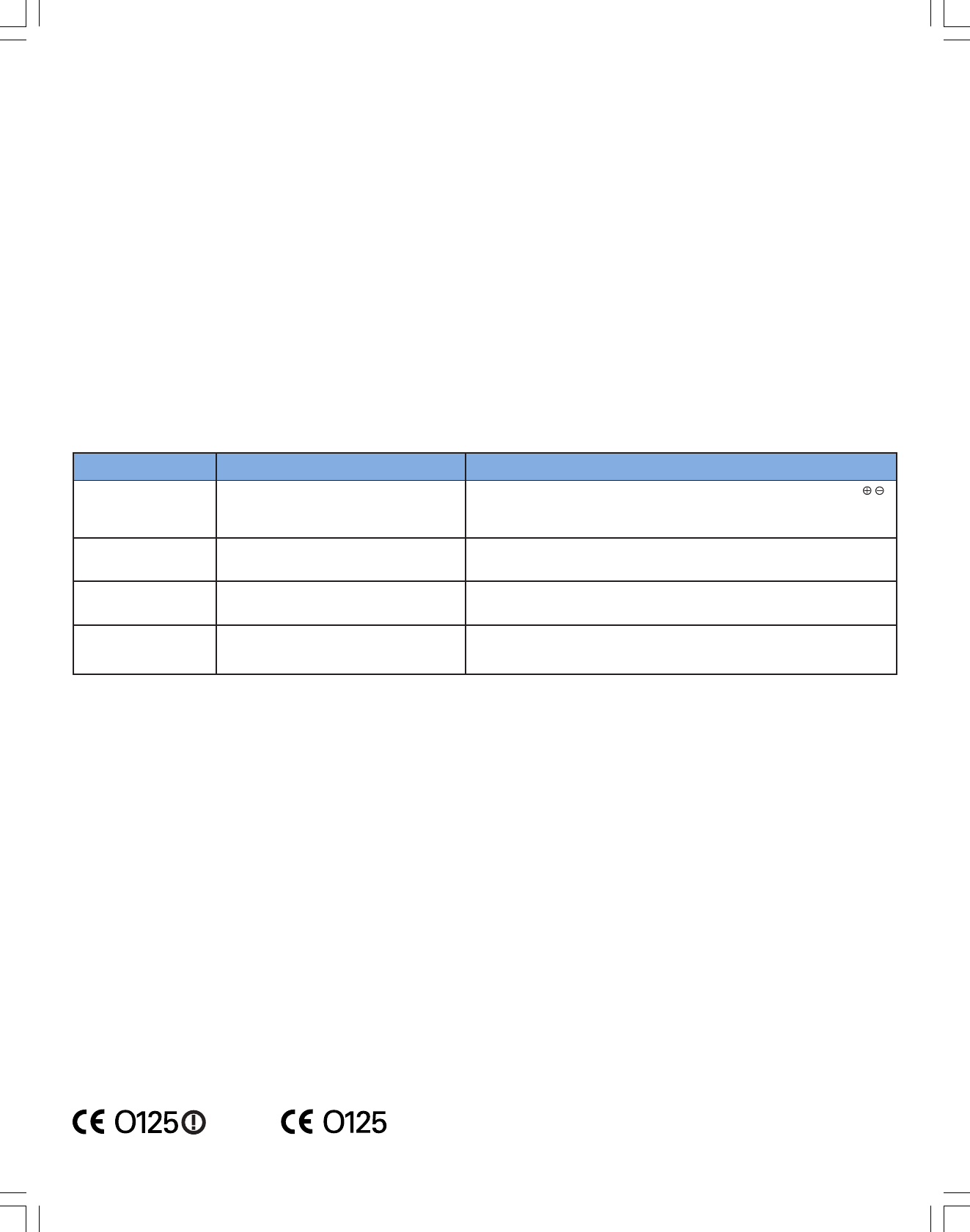
P r o b le m
Hovercraft runs slowly,
or w on't m ove, or
won't steer
E rratic operation, loss
of control, short range
Hovercraft s tops
working after going in
water or snow
B attery life is s hort
P ro b a ble C au s e
- B atteries dead or low
-B atteries installed incorrectly
- Loose battery connection
- Power switch is off
-R adio interference
-Weak Transmitter battery
-Weak hovercraft battery
-Water in battery/electronics/motor areas
- B attery pack not charged fully
- B attery pack charged w hen hot
- B attery pack faulty or worn out
C o r r e c t i o n
-R em ove and replace batteries, making s ure battery direction (polarity, / )
is correct and battery com partm ent contacts are clean.
- R echarge hovercraft battery. R eplace transmitter battery.
-Turn on Pow er switch.
- M ove to another location.
- Point antenna up in the air, not at hovercraft. Don't touch antenna.
- R echarge 6.0V battery pack or replace 9V (6F22) battery in transm itter.
-Turn power s witch off IM M E DIAT E LY, remove all batteries , dry inside and
out w ith clean s oft cloth and allow to dry overnight with battery door off.
- R echarge battery pack
-Always allow battery pack to cool before charging
- R eplace battery pack
PR IN T E D IN CHIN A
© 2004 Taiyo K ogyo Co., Ltd. 1-23-17, Higas hiyotsugi, K ats ushika-ku, Tokyo, J apan A ll R ights R es erved. Product specifications subject to change.
Product may differ from illustrations.
A304
H o v er c r a f t T ips
1. In order to race or operate two hovercrafts together, one m us t be 27M Hz (S ilver/B lue) and one m us t be 40M Hz (S ilver/R ed).
2. Hovercraft are not designed to go up hills or inclines .
3. W ater should be calm, without w aves , turbulence or s trong currents . Do not operate in rivers or s treams.
4. Do not operate hovercraft in s alt water. S alt w ill corrode m etal parts and void w arranty.
A ir B a g S k ir t C a r e
1. Do not operate your hovercraft where the s urface is w ith s harp edge, rough s urface or high tem parture heat to avoid s kirt wreck or w orn out in
order to m ake A ir B ag S kirt last longer.
2. W hen the A ir B ag S kirt has been accidently wrecked or worn out, do not repair by yours elf, because of it's particular s kirt s ealing structure. Please
kindly contact the Cus tum er S ervice Hot Line indicated on the first page of the M anual, or contact the s hop where you have purchas ed.
R /C F a c t s f o r Im pr o v ed O pe r a tio n
1. W hen battery s tart to fully dis charge, hovercraft may s low, s top, or refuse to respond to your control. It's time to recharge hovercraft battery or
replace transm itter battery. T his is abs olutely the #1 cause of all problem s and ques tions !
2. R adio frequency interference can interfere with the control of your hovercraft. B uildings , power wires , other R /C transmitters , or CB radio can all
caus e problem s . Pick a place to drive and keep away from these things .
3. Hold Transmitter so antenna points up, not tow ard the hovercraft. K eep hovercraft within range (about 20 meters) to keep control. If hovercraft goes
out of range, try lifting trans m itter high into air to increas e range for hovercraft recovery.
4. W ipe hovercraft clean and dry after each use, including ins ide battery com partm ents.
5. Turn hovercraft power s w itch off immediately after running. R em ove batteries for s toring. K eep hovercraft and Trans m itter aw ay from heat and
direct sunlight and m ois ture.
T r o u ble s hoo t i ng G uide
Don't take your hovercraft back to the store--try s olving problem s using this valuable guide.
S taatweg 111, 3621 B K B reukelen Holland
(27MHz)
(40MHz)
NOTE:
The manufacturer is not responsible for any radio or TV interference caused by unauthorized modifications to this equipment. Such
modifications could void the user's authority to operate the equipment.